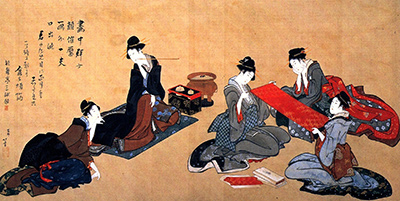Hokusai
Portrait of Chino Hyogo Seated at his Writing Desk by Hokusai
The Japanese ukiyo-e print, Portrait of Chino Hyogo Seated at his Writing Desk, was made by the famous exponent of polychrome woodblock prints, Katsushika Hokusai, and is normally kept at the Tokyo Fuji Art Museum in Japan.
The ukiyo-e print was popular in the nineteenth century with ukiyo-e meaning something like images of the floating world. In this work Chino Hyogo is enjoying the company of his friends and has his back to a writing box. Like much of his best work this print was made in the artist’s late period when he went by the name of Gakyo Rojin Manji (the old man crazy about art) this being one of about 30 changes of name. In 1834 he began his celebrated series ‘One hundred views of Mount Fuji’ and the portrait of Chino Hyogo dates from 1835.
There is poetry on the top left hand side of the group portrait and Hokusai had, in earlier periods, illustrated books of poetry including Kyoka Ehon (containing humorous poems) and Toshisen Ehon (a Japanese edition of Chinese poetry). There are extant letters that demonstrate his exacting demands of the woodcutters he used showing the close attention he paid to his work. The Portrait of Chino Hyogo Seated at his Writing Desk is perhaps a humerous work making fun of how writers really spend their time, not by busily writing alone but, in this case, by enjoying the company of five friends seated on the ground.
Chino Hyogo, with a large stick, is sitting with his back to a lacquered writing box and large cooking pot. Two other colourful figures seem to be unrolling a red scroll and, in front of them, are two books and a pen. The poem on the left would probably have added to the unexpected portrait of a writer. Perhaps the main point is that worthwhile writing comes from an understanding of people formed by the enjoyment of friendships.
